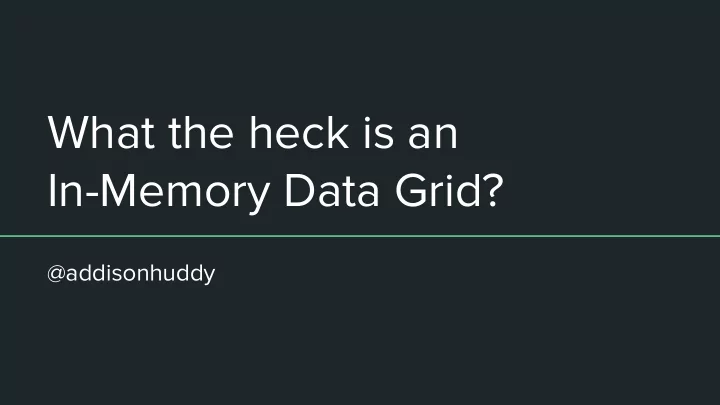

What the heck is an In-Memory Data Grid? @addisonhuddy
How are we going to answer this question? 1. Tell you about my first introduction to IMDGs 2. See some real-world use cases 3. Design an IMDG 4. Implement Use Cases
Definition IMDGs provide a lightweight, distributed, scale-out in-memory object store — the data grid. Multiple applications can concurrently perform transactional and/or analytical operations in the low-latency data grid, thus minimizing access to high-latency, hard-disk-drive-based or solid-state-drive-based data storage. 1 Gartner 1 https://www.gartner.com/reviews/market/in-memory-data-grids
My First Thought
My Second Thought
Two Examples Southwest China Railway Airlines Corporation 5,700 train stations 70+ cities 4.5 million tickets per day 4,000 daily flights 20 million daily users 706 aircraft 1.4 billion page views per day Largest airline website by visitors 40,000 visits per second
When Not To Use An IMDG - Small Amounts of Data - Low-latency isn’t mission critical - Not a total replacement for RDBMS
Let’s Make an IMDG
Design Goals - Extremely Low Latency - High Throughput - Durability - Large Datasets - Consistency?
Design Goals - Memory First - Extremely Low Latency - Horizontal Scalability / - High Throughput Elasticity - Data Aware Routing - Durability - Serialization / - Large Datasets Deserialization - Consistency
https://github.com/apache/geode
Memory First
Latency Comparison Latency Comparison Numbers -------------------------- L1 cache reference 0.5 ns Branch mispredict 5 ns L2 cache reference 7 ns 14x L1 cache Mutex lock/unlock 25 ns Main memory reference 100 ns 20x L2 cache, 200x L1 cache Compress 1K bytes with Zippy 3,000 ns 3 us Send 1K bytes over 1 Gbps network 10,000 ns 10 us SSD Seek 100,000 ns 100 us Read 4K randomly from SSD* 150,000 ns 150 us ~1GB/sec SSD Read 1 MB sequentially from memory 250,000 ns 250 us Round trip within same datacenter 500,000 ns 500 us Read 1 MB sequentially from SSD* 1,000,000 ns 1,000 us 1 ms ~1GB/sec SSD, 4X memory Disk seek 10,000,000 ns 10,000 us 10 ms 20x datacenter roundtrip Read 1 MB sequentially from disk 20,000,000 ns 20,000 us 20 ms 80x memory, 20X SSD Send packet CA->Netherlands->CA 150,000,000 ns 150,000 us 150 ms 1 Credit Jeff Dean, Peter Norvig, and Jonas Bonér
Why Memory? Read 1 MB Comparison Hardware True Time Scaled Time Memory 250,100 ns 2 days SSD 1,100,000 ns 9 days Disk 30,000,000 8 months
Horizontal Scalability / Elasticity
System Architecture Client Server Server Client Client Client Client ... Server Server Client Client Client Client Client Locator Locator
System Architecture Client Server Server Client Client Client Client ... Client Client Client Client Client Locator Locator
System Architecture Client Server Server Client Client Client Client ... Server Client Client Client Client Client Locator Locator
IMDGs & CAP Theorem A vailability C onsistency P artition Tolerance
WAN Replication lient Data Center Data Center (NYC) (Tokyo) S S S S S S S S L L L L
Data Aware Routing
Latency Comparison Latency Comparison Numbers -------------------------- L1 cache reference 0.5 ns Branch mispredict 5 ns L2 cache reference 7 ns 14x L1 cache Mutex lock/unlock 25 ns Main memory reference 100 ns 20x L2 cache, 200x L1 cache Compress 1K bytes with Zippy 3,000 ns 3 us Send 1K bytes over 1 Gbps network 10,000 ns 10 us SSD Seek 100,000 ns 100 us Read 4K randomly from SSD* 150,000 ns 150 us ~1GB/sec SSD Read 1 MB sequentially from memory 250,000 ns 250 us Round trip within same datacenter 500,000 ns 500 us Read 1 MB sequentially from SSD* 1,000,000 ns 1,000 us 1 ms ~1GB/sec SSD, 4X memory Disk seek 10,000,000 ns 10,000 us 10 ms 20x datacenter roundtrip Read 1 MB sequentially from disk 20,000,000 ns 20,000 us 20 ms 80x memory, 20X SSD Send packet CA->Netherlands->CA 150,000,000 ns 150,000 us 150 ms 1 Credit Jeff Dean, Peter Norvig, and Jonas Bonér
Single Hop Client Server Server Client Client Client Client ... Server Server Client Client Client Client Client Locator Locator
Local Cache Client Server Server Client Client Client Client ... Server Server Client Client Client Client Client Locator Locator
Local Cache Client Server Server Client Client Client Client ... Server Server Client Client Client Client Client Locator Locator
Serialization 1. Only (de)serialize when it is necessary 2. Only (de)serialize what is absolutely necessary 3. Distribute (de)serialize cost as much as possible
Basic User Operations
What have we created? - Put/Get - Key/Value Object Store - Queries - Share-nothing - Server-side functions architecture - Registered Interests - Continuous Queries - Memory Oriented - Event Queues - Strongly Consistent
Use Cases
In-line Caching S S Client Client RDBMS Client Client C S S L L
Look-Aside Caching RDBMS Client Client Client Client C S S S S L L
Look-Aside Caching RDBMS Client Client Client Client C S S S S L L
Pub / Sub System 1 Client Server Server Client Client 2 Client Client ... 2 Server Server Client Client Client Client Client Locator Locator
Real-Time Analytics with Functions Client Server Server Client Client Client Client ... Server Server Client Client Client Client Client Locator Locator
Distributed Computation Client Server Server Cient Server Server Client
Real-Time Analytics Client Client Client Server Server Client Rapidly Changing Data Client Client Server Server Client Client Client
O’Reilly Book
Questions @addisonhuddy
Recommend
More recommend